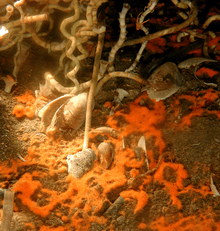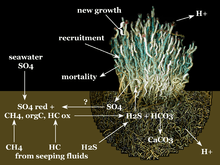Lamellibrachia luymesi
| Lamellibrachia luymesi | |
|---|---|
 | |
| Lamellibrachia luymesi | |
| Scientific classification | |
| Kingdom: | Animalia |
| Subkingdom: | Eumetazoa |
| Phylum: | Annelida |
| Class: | Polychaeta |
| Subclass: | Palpata |
| Order: | Canalipalpata |
| Suborder: | Sabellida |
| Family: | Siboglinidae |
| Genus: | Lamellibrachia |
| Species: | L. luymesi |
| Binomial name | |
| Lamellibrachia luymesi van der Land & Nørrevang, 1975 | |
Lamellibrachia luymesi is a species of tube worms in the family Siboglinidae.
It lives at deep-sea cold seeps where hydrocarbons (oil and methane) are leaking out of the seafloor. It is entirely reliant on internal, sulfide-oxidizing bacterial symbionts for its nutrition.


Lamellibrachia luymesi provides the bacteria with hydrogen sulfide and oxygen by taking them up from the environment and binding them to a specialized hemoglobin molecule. Unlike the tube worms that live at hydrothermal vents, Lamellibrachia uses a posterior extension of its body called the root to take up hydrogen sulfide from the seep sediments. Lamellibrachia may also help fuel the generation of sulfide by excreting sulfate through their roots into the sediments below the aggregations.[2]
The most well-known seeps where Lamellibrachia luymesi lives are in the northern Gulf of Mexico from 500 to 800 m depth. This tube worm can reach lengths of over 3 m (10 ft), and grows very slowly, and its longevity is over 250 years. It forms biogenic habitat by creating large aggregations of hundreds to thousands of individuals. Living in these aggregations are over a hundred different species of animals, many of which are found only at these seeps.
References
This article incorporates a CC-BY-2.5 from references.[1][2]
- ↑ 1.0 1.1 Boetius A. (2005). "Microfauna–Macrofauna Interaction in the Seafloor: Lessons from the Tubeworm". PLoS Biology 3(3): e102. doi:10.1371/journal.pbio.0030102
- ↑ 2.0 2.1 2.2 Cordes E. E., Arthur M. A., Shea K., Arvidson R. S. & Fisher C. R. (2005). "Modeling the Mutualistic Interactions between Tubeworms and Microbial Consortia". PLoS Biology 3(3): e77. doi:10.1371/journal.pbio.0030077